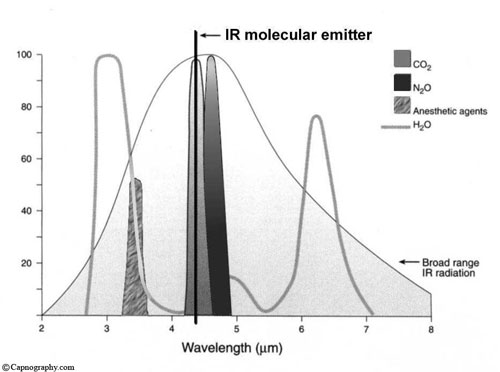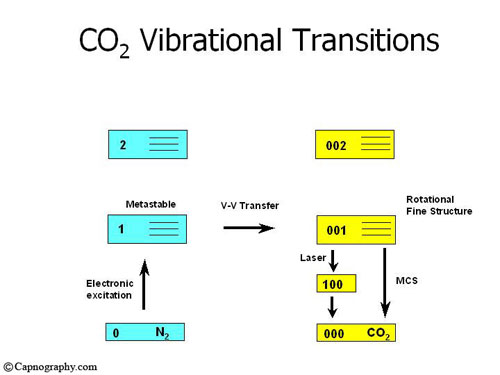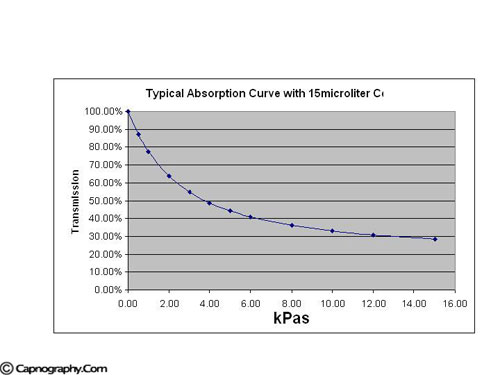Molecular Correlation Spectrography (MCS)
Microstream technology uses a novel MCS source that operates at room temperature and emits only CO2 specific radiation (figure below, permission from Krauss B).3 (cube)

The mechanism of MCS is:
1. The source, unlike the black body IR radiator, is an all glass discharge lamp, without an electrode, coupled with an IR transmitting window which is either sapphire (for very high outputs and low noise) or high transmitting IR glass (for standard functions). The glass lamp undergoes a special cleaning process as well as chemical conditioning before being filled with a carefully balanced mixture of up to 7 gases at low pressure. Electrons generated by a radio frequency voltage excite Nitrogen molecules, one of the gases within the source.
2. Carbon dioxide molecules are then excited through collision with the excited nitrogen molecules as energy is transferred from Nitrogen to the CO2 molecules. As the excited CO2 molecules drop back to their ground state they emit signature wavelength of CO2, which is the radiation emitted from the source (see figure below, permission from Krauss B).3

The IR source is electronically modulated at a frequency of 40 hz so that a measurement can be sampled every 25 msecs. This preserves a rapid response time while maintaining optimal signal characteristics without degradation. The amplitude of each signal received by the detector is dependent on the amount of radiation absorbed from the gas sample that is proportional to the CO2 concentration. The signals from the optical detector are amplified and frequency locked before being delivered for peak to peak sampling with 12 BIT A to D converter. This provides a 25 msec periodic voltage signal, reflecting the level of CO2 absorption. These voltages are then transformed to CO2 concentrations using the anticipated absorption curves for the instantaneous ambient conditions. Because of the highly specific nature of the MCS source, the exponential shaped absorption curves are very deep (see figure below, permission from Krauss B).3

To further enhance the waveform signal to noise, without affecting the response time, dynamic averaging of the 25 msec signal is used. The degree of dynamic averaging is proportional to the rate of change of the signal. In this method, only with slow changing signals, indicative of the alveolar CO2 plateau or the inhalation phase, is averaging applied. When fast changing signals are detected, indicative of the ascending CO2 upstroke, all signal averaging is removed.
Microstream employs a flow rate of 50 ml/min, one-half to one-third the rate typically required by conventional side-stream capnographs. It has been suggested that the low flow rate reduces the entry of moisture and humidity that can condense in the sampling line and obstruct the sample pathway – a common problem with conventional side-stream technology.3 The low flow rate also maintains accuracy while eliminating the competition for tidal volume, common with high flow rate capnographs in infants and neonates. A flow rate as low as 50 ml/min was not generally provided with previous capnographs since it had a detrimental effect on response time., the ability to address rapid respiratory rates, and the ability to measure CO2 accurately without mixing.
* For further details on this technology, refer reference #3.

 Twitter
Twitter Youtube
Youtube











